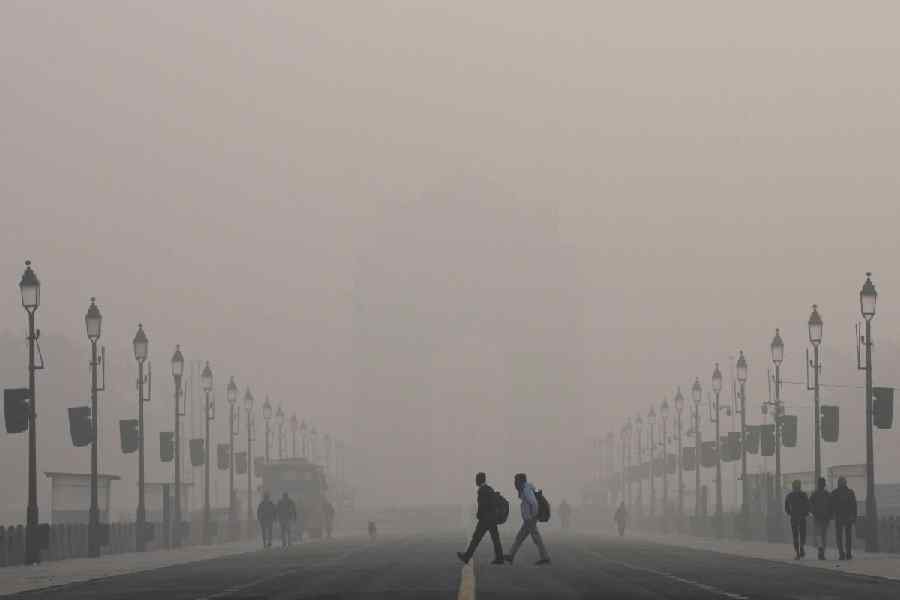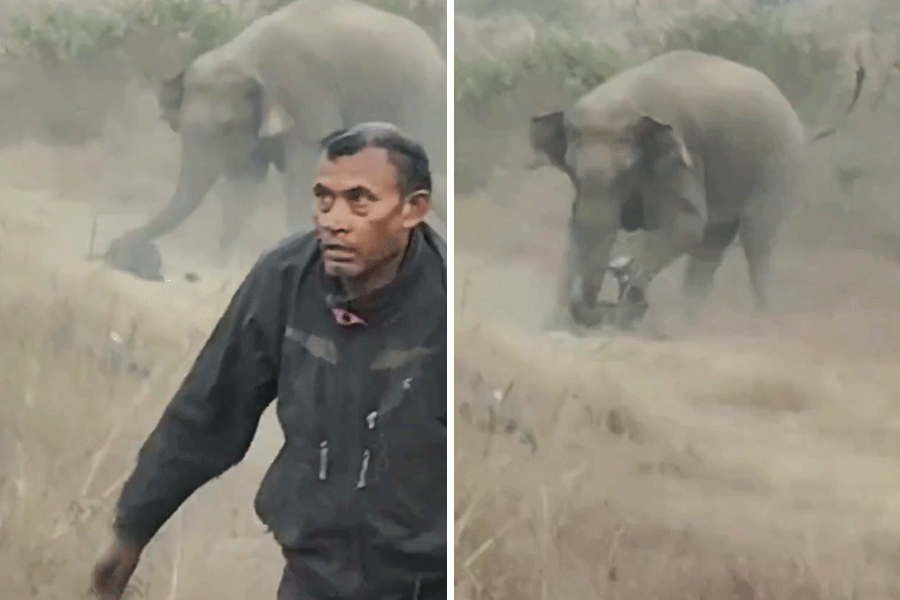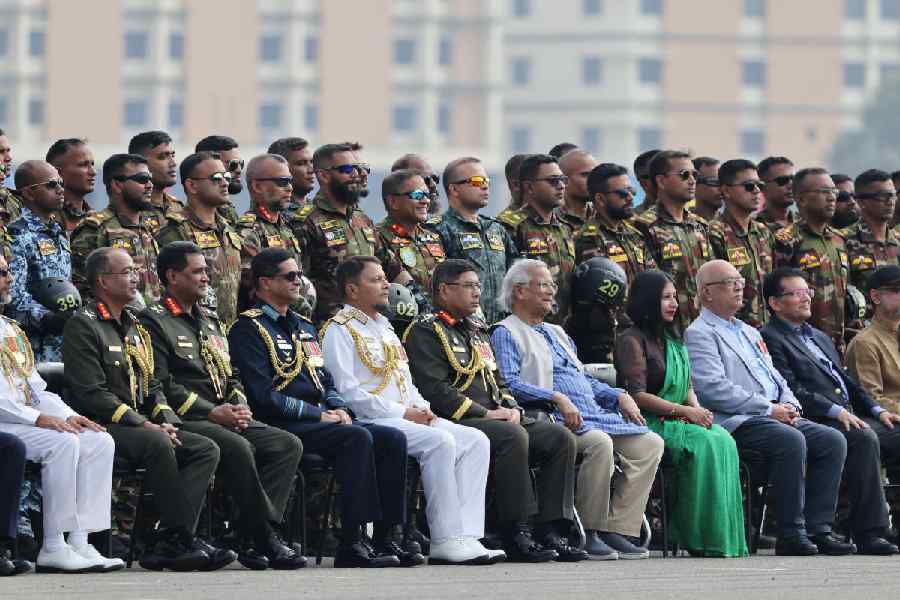 |
Almost 45 years ago, in the late 1960s, when West Bengal was in the throes of political turbulence, a young lad who had barely stepped into adulthood arrived in Calcutta in search of inner tranquillity. He was also in search of the key to his life — to unravel the many mysteries of existence which he did not find in his home, almost 2,000 kilometres away. Home for this wiry lad was a nondescript village with a mythical past whose narrow streets of cobblestones wound their way up a small hillock to his none too impressive home. The small tenement sheltered his parents and five siblings — four brothers and one sister.
The City of Joy was not this lad’s destination — he was headed for Belur Math on the outskirts, where he hoped to find answers to his many questions, besides, of course, finding a shelter and an escape from the mediocrity of his lower middle-class existence. But above all, the reason he wanted to take deeksha and join the Ramakrishna Order of Monks was because the life of a celibate seer was also an escape from a reality back home — that he was betrothed to a girl while still a child, someone with whom he did not wish to cohabit but this had become inescapable because the first two stages of the three-phased customary child marriage had been completed when he was younger.
But the young man was not drawn to the Ramakrishna Mission solely for selfish reasons. Already, in his short life he had been greatly influenced by Swami Vivekananda. He spent considerable portions of the money he received for his labours at the tea shop his father Damodardas owned on the books of Vivekananda. He did not have a great understanding of the spiritual dimension of Vivekananda but was drawn mainly by the romantic halo around him and his views on patriotism, the concept of which had greatly driven the boy when he was growing up in a region bordering Pakistan. He was also drawn to the idea of seeking deliverance through the institution set up by Swami Vivekananda because he shared something fundamental with the seer: his name — Narendra.
The lad — who, at 62, is now the longest serving chief minister of Gujarat, Narendra Modi — however, could not make Belur Math the place to cast anchor. After spending some months at the headquarters, he had to depart — unable to join the Order because he was not a graduate [the minimum eligibility is a higher secondary qualification, but the Mission prefers graduates and post-graduates]. Before leaving home he had dropped out of formal education after clearing his intermediate school in Gujarat’s Mehsana district.
But Narendra Modi, though staging an escape from his home and his destiny, was not a runaway when he arrived in Calcutta. He had, in fact, informed his parents that he wished to opt out. The family — especially his parents, were given no choice — it was the proverbial offer they could not refuse.
 |
| Making of modi: The chief minister as an NCC cadet and (below) in his youth |
 |
This habit of Modi of presenting others with a fait accompli was acquired early and has become the hallmark of his political and individual persona. In the course of the preparations for the next week’s state Assembly elections, Modi used the central leadership solely to endorse his position. Though candidate lists were ostensibly finalised by the Bharatiya Janata Party’s central election committee, when he arrived in New Delhi on two occasions in the last week of November he carried with him the names of nominees and a non-negotiable posture.
Many clues to Modi’s characteristics are found in Vadnagar — his village that has now grown into a township with a population of more than 27,000. It’s courtesy the “special care” taken by Modi that the town is soon to have a medical college, two ITIs, besides significant industrial investment by a private player. Old friends, acquaintances and an odd schoolteacher remember him fondly.
However, when they scrape the rust from their memories and let emotions flow, recollections of Modi’s stubborn attributes tumble out. Similar is the case in regard to his leadership qualities and desire for extra-curricular activities — be it debating, joining activities to cheer soldiers heading for the battlefields in 1962 and 1965, or even the daily shakha of the Rashtriya Swayamsevak Sangh (RSS). His elder brother, Somabhai Modi, uses polite words when asked if the younger sibling displayed an authoritarian streak early on: “Right from his childhood, he was very disciplined and determined. If he decided he had to do something, he would do it in any way.”
In each activity he participated as a child, it would be only his way — and no one else’s. An almost octogenarian one-time neighbour, Maniben Modi, claims that the chief minister of the day played in her lap as a toddler but was even then “very stubborn and naughty”.
As a student too Modi battled electoral odds. He once fought an election in Class IX to become a class representative. His rivals had better prospects but by sheer effort during the campaign, he was able to win the election. One of his teachers, Prahladbhai G. Patel, recalls how Modi once refused to follow instructions to show his homework to a fellow student. “He said, only teachers had the knowledge to check the tasks,” says Patel. Teachers concluded that though Modi’s refusal was an “act of disobedience”, it also indicated “a rebellious streak and leadership qualities”.
Nothing has come Modi’s way on a platter. He was born into an OBC family, traditionally traders in oil. His father moved homes — and towns — in search of better avenues. When Modi was born in September 1950, Vadnagar was a tiny hamlet with more empty spaces than people. There were several ancient temples and the village was believed to have been home to the legendary sisters — Tana and Rivi — who helped Emperor Akbar’s jewel, Mian Tansen. The assistance, the story goes, was provided when Tansen was suffering from a burning sensation after a near-perfect rendering of Raga Deepak at Akbar’s behest. The two sisters helped the court singer cool off by a moving recital of Raga Malhar.
Damodardas ran a tea shop outside the local railway station. It was here that Modi took his first public steps by joining sloganeers demanding a separate state of Gujarat in the mid-1950s, when it was part of the unified Bombay state.
It is a different matter that neither in 1956-57 nor in 1960, when Modi took the lead in celebrations in school to mark the birth of Gujarat, did he have any political understanding. “I only understood that there was something politically significant happening and as a child I got a sense of participation in it,” he tells me. With the benefit of hindsight, one can also add that by joining agitators he also earned himself an identity — that of the youngest activist.
But Modi took a much bigger stride in 1967 when he began the long journey away from home. He is reticent about his activities during those years, but after he left Belur, Modi headed for the place where most young men seeking to resolve inner angst go: the Himalayas. Once there, he spent some time at the Vivekananda Ashram in Almora.
In early 1971, Modi decided to return home. But the possible mention of the impending gauna (a nuptial ritual) with Jashodaben — the “wife” about whom Congressman Digvijay Singh wanted him to come clean on, in the wake of the controversy sparked by Modi with his comments on Sunanda Pushkar — made him leave Vadnagar, this time virtually forever. Even now he maintains minimal contact with his family, meeting siblings only occasionally, though he does visit his mother more often. She stays with a younger brother who works in the state information department and has been allotted small living quarters in Gandhinagar. He goes home on his birthdays and a few religious occasions. But he is rarely alone in these visits: the bite-brigade follows, documenting every utterance and every display of emotion.
Media management has been Modi’s hallmark. With probably the maximum presence among Indian political leaders in cyberspace, he uses every conceivable platform: individual website, Google Plus for Hangouts, Facebook, Twitter and YouTube. Since January he has also been tweeting a quote of Vivekananda daily, often with an oblique political connotation.
Managing information flow is a skill Modi picked up during the Emergency when he was a junior functionary in the RSS. When Modi was directed to go underground, his theatrical skills picked up in school came handy. For instance, he once travelled disguised as a bearded elderly man, modulating his voice to suit his character. A former teacher he happened to meet failed to recognise him.
He met political stalwarts — of the Sangh Parivar and those outside — George Fernandes, Madhu Limaye, Eknath Ranade and Dattopant Thengadi. Playing a key role during the Emergency was a natural progression for Modi from his first tasks in Hedgewar Bhawan, the RSS headquarters in Ahmedabad. Having been assigned a small but important role during the Navnirman Movement (a socio-political movement in Gujarat in the mid-Seventies), Modi was an automatic choice for the Gujarat Lok Sangharsh Samiti which the RSS floated. Among other things, he prepared, printed and dispatched anti-Emergency pamphlets and booklets, sometimes carrying them to Delhi himself.
After the Emergency, Modi grew through the ranks of the RSS in Gujarat, though he made it evident to colleagues that he desired a more direct political role. This came within a year of Lal Krishna Advani becoming party president in 1986 when, as part of moves aimed at resurrecting the BJP after its setback in 1984, it decided to revive the practice of “leasing” pracharaks from the RSS.
Modi became general secretary of the Gujarat unit of the BJP around the time the fortunes of Rajiv Gandhi began dipping. The BJP started playing a key role in coalescing an anti-Congress political front. With the Sangh Parivar striking success with the Ayodhya agitation, when Advani decided to embark on a rath yatra, the task of giving it a good start in Gujarat fell on Modi. A year later — after the 1991 parliamentary polls — Modi became Murli Manohar Joshi’s charioteer for the Ekta Yatra, a success for Modi as far as his organising skills went.
The Ekta Yatra marked two decades of Modi’s career in the Sangh Parivar and this was the first time he had to take a beating as his unpopularity among senior state BJP leaders resulted in his marginalisation. Several leaders felt he was riding roughshod over them because he had a “direct line” to leaders in Delhi. But Advani stepped in to ensure a significant role for Modi and he played a major part in the campaign that saw the BJP sweep the Assembly polls in 1995. His main job was to finalise the campaign schedules of senior leaders and ensure that local units made proper arrangements for public meetings. He also played a role in candidate selection in Gujarat.
With Keshubhai Patel as the chief minister, Modi held his first “extra-constitutional” post as “super CM”. This was not acceptable to the other stalwart of the state unit at that time, Shankersinh Vaghela. Nor did Modi get much support from the leadership of the Sangh Parivar for such usurping of power. As a result, Modi was plucked from Gujarat and cast away as national secretary stationed in Chandigarh with the charge of the smaller northern states — Haryana, Punjab and Himachal Pradesh. People who interacted with him then say for the first time they saw a harried look on his face — a “kind of sarvahara (utter despair)”, as one associate puts it.
But Modi is a person who seizes even the smallest opportunity to stage a political comeback. In this case, he had to begin his political resurrection by shepherding the BJP in the election for the Chandigarh Municipal Corporation in 1996. India was going through political upheavals — three prime ministers in two years had resulted in the Lok Sabha being dissolved. The BJP in Gujarat also committed hara kiri and the government fell with Vaghela quitting the party with his loyalists and forming a government with Congress support.
But parliamentary elections were held along with state elections and both resulted in the BJP forming governments, in Gujarat with almost a two-third majority, and at the Centre at the head of a coalition government. Modi played an important role in both the polls. Soon thereafter, he made it to the Indian capital — first as party general secretary and within a year as the party’s spokesman. But he was only half way up the tree he wished to climb. And that was the chief ministerial seat in Gandhinagar.
Modi would not have been chief minister had Keshubhai Patel not made a mess of his regime and failed to perform on the front that needed priority attention: efficient management of relief and rehabilitation in the wake of the Kandla cyclone in 1998, the Ahmedabad flood in 2000 and the January 2001 earthquake. The failures of the Patel government resulted in setbacks in bypolls and by October 2001, the Sangh Parivar leadership had been sufficiently “worked upon” by Modi and his supporters. But when he ascended the throne, the platform was wobbly — and remained so for several months.
Time was running out as Assembly elections were due in early 2003. When the reports of the Godhra carnage came it, Modi knew that his big ticket issue had been delivered on a platter.
Barely a week before that, Modi managed to win a bypoll to the state Assembly but failed to ensure the victory of the party in two other seats. But overnight, the post-Godhra violence transformed a struggling political greenhorn into the Lord Protector of Gujarati asmita (pride). Modi facilitated this makeover by using means that are still being contested in courts.
The key elements of the Modi personality that probably would have remained unnoticed but for Godhra can be listed till eternity — so significant has been his role in the churning of Gujarati society and so profound has been his impact on majority-minority ties. Modi has mixed his “only one person counts” principle with a sheen of designer kurtas, watches, pens and spectacle frames.
There is probably no one who can claim that Modi considers her or him a friend. Every person in Modi’s life has a utilitarian role — just like any service provider. He does not grudge his loneliness. Modi in fact, enjoys it because he can pursue, without any distraction, his main passion: the pursuit of power.
The verdict will be soon out on whether Modi is still the man of 2002 or whether he has actually made a transition. At 62, it is a make or break moment for him. A victory in Gujarat would enable him to take the next step — the one to the Indian citadel. A defeat here — or even a wafer-thin majority — will soon have him fighting for survival in the Sangh Parivar. A section of the RSS leadership considers a powerful Modi a threat to their hegemony in the Parivar. Nagpur would not wish to move to the back seat and has supported moves to contain the Modi threat.
After having weathered many a storm, Modi probably faces the sternest test in his career where there is absolutely no room for error. But this is the way he has always played the game: raising stakes to such levels that it wracks the nerves of his detractors.
(Nilanjan Mukhopadhyay is the author of a biography of Narendra Modi which will be published soon)











